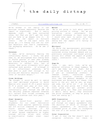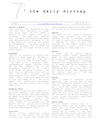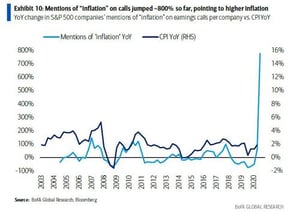Tl;dr - Earlier this week I wrote about the decay of solo thought, quiet reflection, and contemplation on B2B strategy. Now we'll zoom in from the theoretical (why thinking matters) to the constellation of business issues that are rapidly coalescing into a challenging business environment. Instead of snapping back to Feb, 2020, we're entering a period that will require management muscles that have atrophied over the past couple of decades. Will all these trends mature and happen as predicted? Of course not, but that doesn't eliminate the need to plan for them.
A Return to Business Endurance
How many articles have you read on "new normal" vs. "no normal" vs. "back to normal" and other variations?
There's been lots of lazy market trend analysis about how the past couple of decades of the business environment will project forward, albeit with some zigs and zags like more remote meetings and less travel.
That's been simplistic and naive, but the past ten days have done more to clarify the market trends of the next five years for most middle-market industrial manufacturers than all the analysis of the past Annus Horribilis.
The business meta climate is shifting. Here are indications of market trends that are going to characterize the environment as we roll the calendar from 2021 to 2022 and beyond.
- Rising prices
- Rising taxes
- Growing regulatory uncertainty
- Peak Paternalism
- Systems and efficiency - with embedded resilience
- Irreverence and independence among buyers
Let's tackle these, one by one, then in aggregate, and finally explore how you might adapt your strategy and position your company.
Inflation - Rising Prices
I recommend Jared Dillian's Daily Dirtnap newsletter for high-level economic trends (and the Mauldin Economics events and newsletters with which Jared is affiliated.) In support of his thesis on inflation, here are a couple of items from the past week.
First, a tweet from @CharlieBilello.
Commodity prices over last year...
— Charlie Bilello (@charliebilello) April 20, 2021
Lumber: +265%
WTI Crude: +210%
Gasoline: +182%
Brent Crude +163%
Heating Oil: +107%
Corn: +84%
Copper: +83%
Soybeans: +72%
Silver: +65%
Sugar: +59%
Cotton: +54%
Platinum: +52%
Natural Gas: +43%
Palladium: +32%
Wheat: +19%
Coffee: +13%
Gold: +3%
Next, a digest of CEO comments on earnings calls which Dillian sourced from JonesTrading's Mike O'Rourke (the images are intentionally small since this is subscription material - I suggest you get your own.) Here's the skinny:
 O'Rourke included excerpts from CEOs of:
O'Rourke included excerpts from CEOs of:
- P&G
- Honeywell
- KC
- Coke
- Pepsi
- Nestle

- Danone
- Boston Beer (Sam Adams)
- Celanese
- Crown Cork
- Steel Dynamics
- Mattel
- Whirlpool

- Snap-On
- GATX
- Dover Corp
- Sonoco
- TE Connectivity
- Badger Meter
 They all said the same thing. (The ZeroHedge graph at right charts mentions of "inflation" from earnings calls.) Input and operational costs are rising quickly. Ingredients and components were mentioned, and almost without exception, they specifically called out rising costs for packaging and transportation. And we know that supply chain constraints are impacting availability regardless of price for certain materials including semiconductors, plastic resin, and now even rubber. We should anticipate growing numbers of components and materials subject to allocation, and your finance and procurement teams should be regularly updating simple industry trend analysis.
They all said the same thing. (The ZeroHedge graph at right charts mentions of "inflation" from earnings calls.) Input and operational costs are rising quickly. Ingredients and components were mentioned, and almost without exception, they specifically called out rising costs for packaging and transportation. And we know that supply chain constraints are impacting availability regardless of price for certain materials including semiconductors, plastic resin, and now even rubber. We should anticipate growing numbers of components and materials subject to allocation, and your finance and procurement teams should be regularly updating simple industry trend analysis.
Warren Buffett weighed in as well at the Berkshire annual meeting. "We are seeing very substantial inflation. It’s very interesting. We are raising prices. People are raising prices to us and it’s being accepted... The costs are just up, up, up...just every day they’re going up."
These increases are affecting every one of your suppliers, your company, your competitors, your customers and prospects, and their buyers.
You must be planning for this.
That means efficiency, increasing input costs, increasing your prices, lengthening lead times, and other financial angles.
More importantly, you need to be thinking on behalf of your buyers - how can you help them address what is suddenly one of their most pressing challenges? What about your products and services can help them ameliorate the impact of these changes on their business? That's the key to yours in the medium term.
Rising Taxes
In the past week, we've heard of dramatic increases in capital gains, funding for IRS regulatory efforts, and higher corporate taxes.
Whether your customers' businesses are typically large public corporations or mid-sized privately held pass-throughs, taxes will impact business decisions across the entire investment and operations spectrum.
They will dictate more rigorous planning and analysis(capital investment in the short term and capital gains in the long term) - and therefore create higher hurdles for projects. In some cases, while the gross return might be compelling, the net return will not - and projects will wither...lost to the uber competitor - the status quo.
Operational decisions will generally reflect the narrower post-tax margins that companies will earn.
In other words, a whole range of tax factors, including uncertainty, will complicate your complex sales process.
Increased Regulation
In the past week, we've learned of "environmental justice" regulations under consideration and of proposed refrigerant regulations based on the little-publicized "American Innovation and Manufacturing Act" from the Dec COVID spending bill.
Whether it's extended permitting for greenfield expansion projects, hesitance to disrupt grandfathered status of existing plants, new reporting requirements, higher minimum wages, or any of a range of other regulatory impacts of a more aggressive government zeitgeist, regulation will impact decisions. More on that topic here.
Peak Paternalism
This week Basecamp sort of shook the corporate world. This is an avant garde, enlightened software company. They announced a cessation of any discussion of social issues or politics on internal channels, and of all committees, and compensation in the form of program benefits. You know, the frozen egg and sabbatical sort of stuff. Here's what they said.
For years we’ve offered a fitness benefit, a wellness allowance, a farmer’s market share, and continuing education allowances. They felt good at the time, but we’ve had a change of heart. It’s none of our business what you do outside of work, and it’s not Basecamp’s place to encourage certain behaviors — regardless of good intention.
It's a bit reminiscent of what Coinbase's Brian Armstrong undertook last fall. Turns out it worked out pretty well for Coinbase at the time, and their IPO was certainly enthusiastically received...again, in the last couple of weeks.
Companies are getting back to focusing on their business. Making their products, delivering their services, creating value for their customers. An important part of that is recruiting, retaining, and developing extraordinary talent. But it looks like business is getting back to business and out of the day care and unrelated businesses.
And probably just in time because according to Microsoft research, fully "40 percent of the global workforce considering leaving their employer this year." It turns out, apparently, that all the "amenities" and "benefits" were great to have, but probably just an extra cost.
Systems, Operations, Efficiency, Resilience, Supply Chains
This week, CNN caught many by surprise when they reported on National Tank Truck Carriers Association that they anticipate a shortage of drivers will sideline key tanker delivery capacity this summer, and will likely lead to gasoline shortages at your local station.
That's got obvious logistics implications for your business, but it's also a proxy for so many lessons learned about supply chain efficiency and resilience during COVID. Remember the toilet paper scare, for instance? There was no shortage in aggregate, but the capacity for producing large volumes of course grade large-roll institutional product for airports, convention centers, and offices couldn't be quickly repurposed to meet home use requirements.
Semiconductor shortages, exacerbated by the strategic implications and jockeying, will be a constraint for many machine builders this year. This week we learned from CNBC that it may crimp Apple's results, and NPR reported that Taiwan's science minister doesn't foresee any quick resolution. When your Rockwell and Siemens PLCs and servo controllers are delayed, it's going to create problems that will ripple for you.
Buyers are Pushing Back
Finally, parallelling the corporate moves illustrated by Basecamp, there's a growing resistance to corporate wokeness. This week Vox reported on a frank assessment by James Carville.
Companies are going to realize it's an untenable approach to consistently lose half their customers with pronouncements intended to curry favor with the other half. This trend is the youngest, and this one has more room to run before it starts to show fatigue, but it's coming.
Companies with programs built on core (vs. convenient) philosophies will continue to pursue those. Vocational training, genuine sustainability (not virtue-signaling that trades carbon in one spot for another), and healthy food are examples.
Companies are getting back to business!
What do These Market Trends Mean for Manufacturing Revenue Growth?
We're going back to basics.
Real, challenging business conditions (inflation, taxes, uncertainty, constrained supply) combined with a weariness of tilting at the windmills of the cause du jour will mean that businesses redirect their focus and energy on their core business.
That means the buyers' challenges (which will surely be shaped by these as well), the products and services to address those and create value for buyers, and the operational model to deliver those and to sell them will all receive renewed attention and scrutiny.
You can get a head start for your company.
First, and most importantly, you have to explicitly identify and confront biases in your senior executive team. Not those biases! (I'm confident you're good there.) Rather recency bias, anchoring bias, confirmation bias, Dunning-Kruger effect, sunk cost obsession, and framing effect. Others too, if you really want to get ahead of them!
And then step back and take almost a zero-based approach to thinking about your market, your buyers (and theirs), your products/services, operations, and go-to-market model in the context of the fresh perspective you have.
I can almost guarantee you that there will need to be significant changes in:
- market research, R&D, and product marketing
- budgeting and forecasting
- industrial sales skills and model
- digital, inbound, and manufacturing marketing
My Conversation on Strategy vs. Tactics with Jim Blasingame
I recently appeared on Jim Blasingame's Small Business Radio discussing how the important topics of strategy and tactics/execution are often conflated.
Now is a really important time to clarify the difference for your team; to insist on precision in the use of the terms, and to emphasize the importance of strategy!


